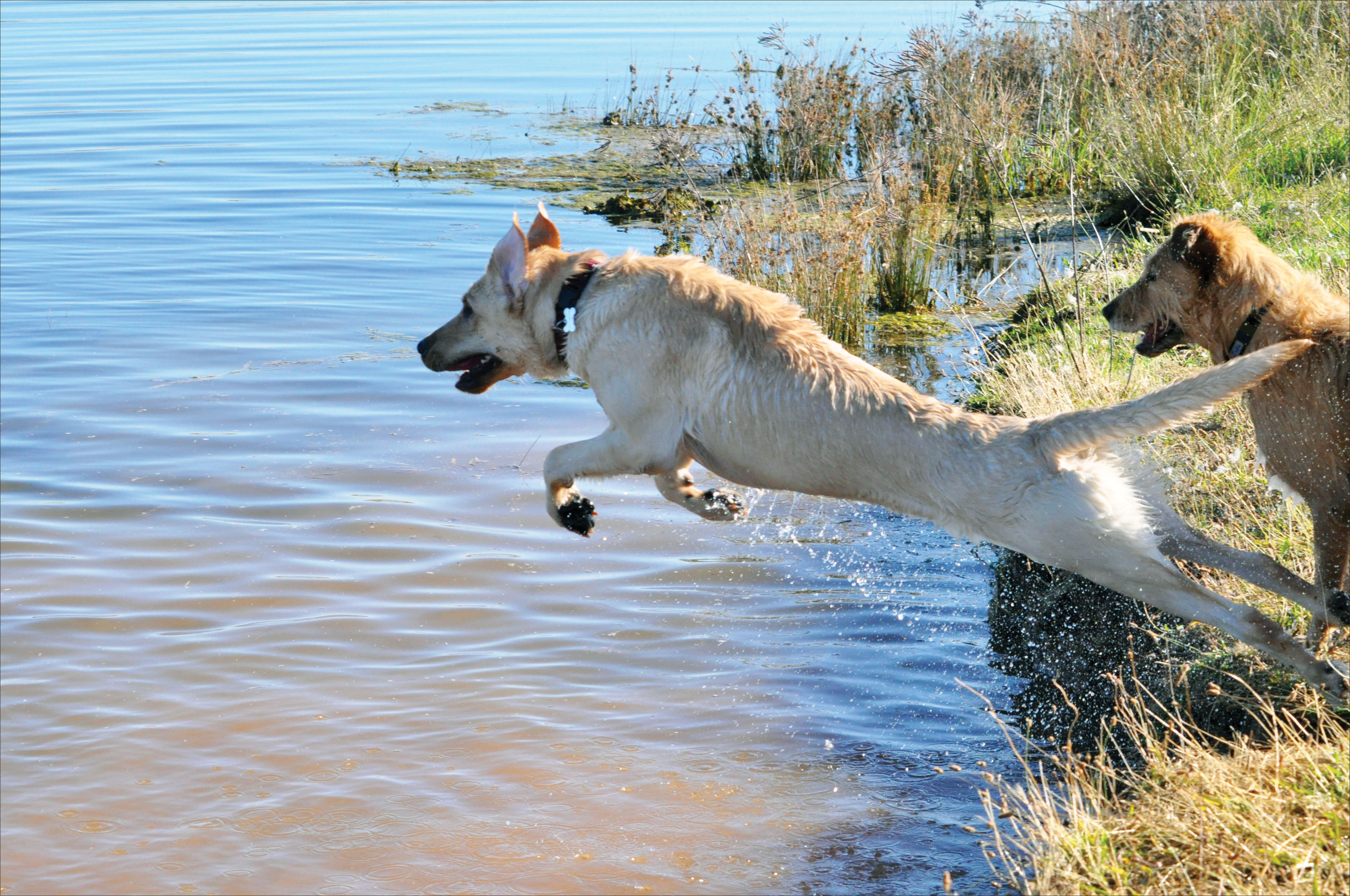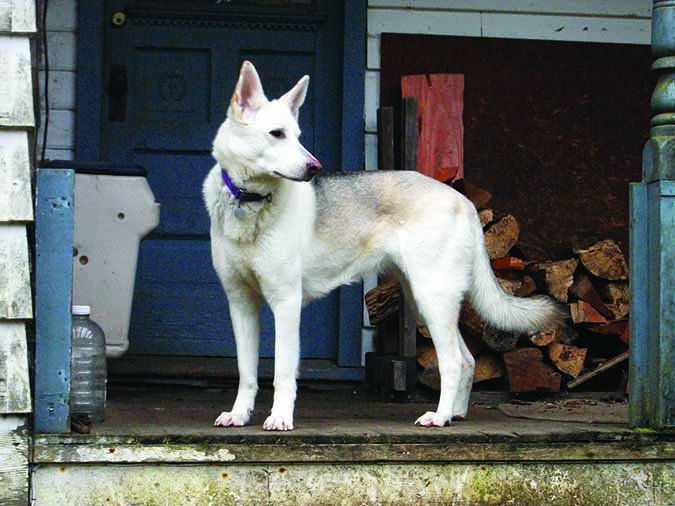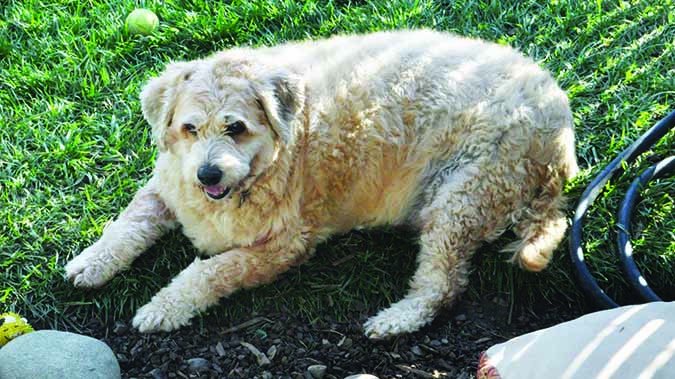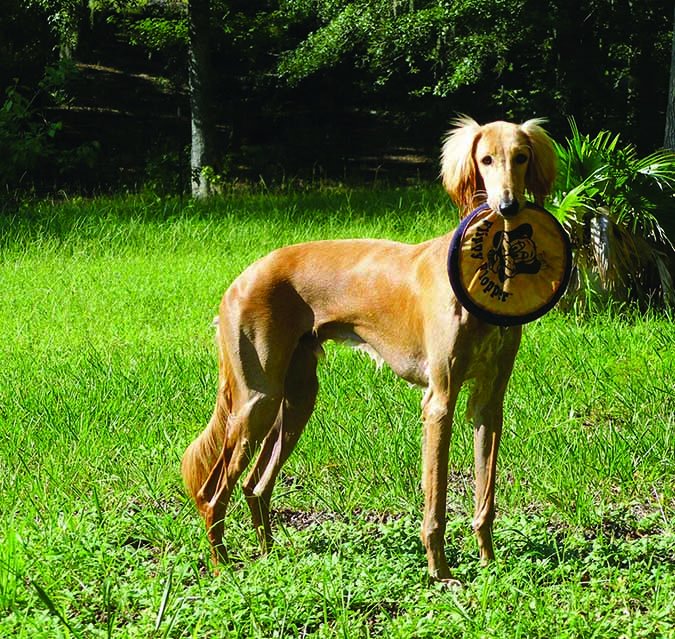In 2003, Holly Marie Johnson of Rainier, Oregon, got some very bad news. Her 2-year-old Shepherd-mix, Kaija, had a severely dysplastic left hip, and surgery was not an option. All the veterinarian could offer was a bottle of glucosamine and MSM supplements, and the advice to “love her for as long as she has.” But almost a decade later, at 11½ years old, Kaija is going strong – “active, cheerful and playful” – a stark contrast to that grim prognosis. “Only in the last year has she shown any signs of pain,” Johnson says, “and then only occasionally, usually when she’s gotten chilled or has been overly active.”
The secret to Kaija’s success wasn’t some new drug, or experimental surgery. It was the simple fact that Johnson made sure she kept Kaija slim, to lessen the pressure on her joints and skeletal structure. If she was going to err, Johnson decided, it would be on the side of slightly underweight as opposed to a few pounds over. And Johnson put Kaija on a regimen of moderate exercise to maintain her muscle tone and help hold her hip in its shallow socket. Johnson concludes, “Had Kaija been overweight, she wouldn’t have made it this far!”

Restricted Diet Helps Dogs Live Longer
Kaija’s story isn’t a fluke: Just as with people, studies show that keeping dogs lean contributes significantly to their health and well-being.
“When we look across all species, from fruit flies to gorillas, we see that caloric restriction improves longevity,” says veterinarian Ernie Ward of Calabash, North Carolina, founder of the Association for Pet Obesity Prevention and a personal trainer who sees the parallels between canine and human obesity. “The body of evidence is pretty strong that the leaner live longer.”
The bellwether research that cemented the benefits of less is more was the Purina Life Span Study, which followed 24 pairs of Labrador Retrievers from 1987 to 2001. Half the dogs were fed their recommended caloric allowance; the other half were fed 25 percent less than what their individual counterparts in the other group had eaten.
The 14-year study found that the dogs with restricted diets lived 15 percent longer – almost two years. Their blood pressure was lower, age-related changes in their immune systems happened later, and they had fewer outward signs of aging, such as graying muzzles.
Like Kaija, a significant percentage of the lean Purina dogs managed to short-circuit the hip dysplasia for which their breed is genetically predisposed: Of the well-fed Labs, 16 of 24 had hip dysplasia by the age of two. Among the 24 dogs with the restricted diet, only eight were diagnosed with the orthopedic disorder.
The benefits of a slim silhouette aren’t just orthopedic: A 2006 study in The Journal of Nutrition found that dogs that developed canine diabetes mellitus were significantly more often considered overweight by their owners at the time they first showed symptoms: Fifty-five percent of owners reported their dogs to be overweight when they became symptomatic, compared with 20 percent of owners of non-overweight dogs.
Overall, the simple truth is that increased calorie intake affects dogs on a cellular level – and not in a good way. While of course there’s no better motivation for keeping your dog thin than knowing you are extending his time with you, there are pragmatic reasons, too. To be blunt: It saves a lot of money.
“The disorders that we’re talking about are costly, and we can’t cure them,” Ward says. “If your dog develops arthritis, there’s no cure for that, unless you give him a total hip replacement. Not only is it debilitating and painful and will cause your animal a lot suffering, it’s going to be a real hit on your pocketbook.”
We’re Overfeeding Like Crazy
Despite the compelling evidence for the up side of slimming down, the reality is that thin isn’t in – at least, not when you’re talking about dogs.
The statistics range from worrisome to downright scary. Banfield Pet Hospital’s 2012 “State of Pet Health Report,” which drew on medical data from 2 million dogs and 430,000 cats that were treated at its 800 hospitals the year before, found that one out of every five dogs and cats is obese. (The accepted definition of obese is weighing 30 percent or more than ideal body weight.) According to Ward’s Association for Pet Obesity Prevention, more than half of all the dogs in America – 52.5 percent – were declared overweight or obese by their veterinarians in 2012. And the numbers are not getting better: The Banfield report says the prevalence of overweight dogs increased a whopping 37 percent between 2007 and 2011.
The poster dog for canine obesity was arguably Obie the Dachshund. Overfed by indulgent elderly owners, the 7-year-old standard-sized smooth Doxie weighed a whopping 77 pounds when he became a national news item in 2012. Looking like a helium-pumped walrus, Obie was so fat he needed a sling to prevent his huge stomach from dragging on the ground. Over the course of a year, Obie’s new owner, certified veterinary technician Nora Vanatta of Portand, Oregon, kept up with a diet and exercise regimen that helped Obie lose so much weight – 50 pounds – that he needed a tummy tuck to tighten up his over-stretched skin.
All kinds of solutions have cropped up to stem the problem of canine obesity and overweight, from iPhone apps like The Fat Dog Diet to a patent for an actual vaccine for obesity. But the first step to solving a problem is recognizing that it exists in the first place.
The ‘Fat Pet Gap’
Despite the fact that Kaija’s outcome was a happy one, the same adjective doesn’t apply to the passersby on the street who sometimes stop Johnson to inform her that Kaija looks malnourished. Sometimes, ironically, they are accompanied by their own butterball-shaped canine.

“People often comment that she looks thin,” Johnson says, adding that the unsolicited criticism has let up a bit over the years, perhaps because more people are educated about the risks of canine obesity. “Some ask if she has been ill. Others assume that she’s a rescue. She actually is, but that’s another story and has nothing to do with her current weight! A few glare at me and say, ‘You really should feed that poor dog.'”
Certainly, there’s no dearth of material in veterinarian offices explaining – and picturing – what a fit dog looks like: Can your dog’s back ribs be felt if you place both your hands across her rib cage? When you view her from the side, does your dog have a “tuck-up” – does her abdomen rise upward from her ribcage to where it meets her leg? If you are looking down at her from above, does she have an identifiable waist?
There’s a name for the mislabeling of a fit dog for a malnourished one, and it has nothing to do with the very real measurements outlined in those “body condition system” posters. Ward calls it the “fat pet gap”: Basically, if a person is constantly surrounded by overweight animals, his or her concept of what is normal begins to unconsciously tilt toward that heavier version.
“We’ve reset the normal perspective of what an animal should look like,” Ward explains. “It’s rare to see a trim Labrador Retriever, so when we do see one, we think he’s too thin. And when we see a 100-pound Lab, we say he’s big boned, or his mom was big, when in reality he’s overweight. There’s substantial evidence to show that we do this for the human condition as well.”
(At this point, we should reassure Labrador Retriever lovers that their breed is not being singled out as preternaturally porky. Labs tend to come up as examples much of the time because they are the nation’s most popular purebred, and owners can tend to overemphasize their naturally stocky build.)
There may be evolutionary reasons for this little dose of self-delusion, Ward adds. As an innate survival instinct, “we may be preconditioned to see thinness as potentially alarming.”
Veterinarians are the first line of defense in making owners aware that their dogs are getting a little thick around the middle. But research shows that some pudgy pooches aren’t getting properly diagnosed in the exam room. A 2006 study found that veterinarians diagnosed overweight or obesity in only 35 percent of dogs whose documented body-condition scores put them in those categories. That’s similar to a 2004 study of pediatricians in which only slightly more than half of practitioners documented obesity in children who met the clinical definition of obese.
Perhaps because our companion dogs are such close reflections of ourselves, there’s an almost linear parallel between human obesity, particularly in children, and the canine version. And, as we know in people, the reasons why people overeat can be complicated. A 2010 study in the Journal of Small Animal Practice in Britain noted that a number of environmental factors were associated with canine obesity. Some you might expect, such as the frequency of snacks and treats, or hours of weekly exercise. But the study also found that an owner’s age and personal income had an impact on the likelihood that his or her dog would be fat. As in human medicine, the researchers noted that awareness of the health risks of obesity is not as high among people in lower socioeconomic brackets.

Don’t Give in to Feeding Table Scraps
Over the years, Johnson didn’t have much difficulty at all keeping Kaija thin. A naturally high-energy dog, Kaija has an equally high-octane “brother dog” who would never allow her to get porky. “She loves to swim, which is a great low-impact, fat-burning, muscle-building exercise for dogs with joint issues,” Johnson adds.
Portion control is easy because Johnson keeps meticulous track of it. “Kaija eats two meals a day, and I measure her food carefully and adjust the amount if she seems to be gaining or losing too much weight,” she explains. Kaija does get high quality, natural treats in moderation – bits of chicken breast, cheese, and homemade dog cookies are her favorites – but Johnson calculates them into her “food budget” for the day.
But even Johnson isn’t immune to those big, pleading eyes. “Kaija is very good at looking hungry, especially when I’m eating,” she says. “Sometimes it’s hard for me to resist, but I know how crucial it is to not start bad habits and give in to those hungry looks.”
Well, most of the time. When she sits down to her own meals, Johnson admits that she usually picks out a dog-safe nibble from her plate -unsalted green beans or carrots, for instance – and sets aside a tiny, treat-size piece for Kaija and her other dog, Gunner, a 4-year-old English Shepherd.
That’s nothing compared to Johnson’s grandmother, who used to slip Kaija table scraps whenever she had the chance. “Grandma loved to feed people and animals, and felt that anyone who wasn’t slightly plump was starving,” Johnson says. “Grandma also equated food with love – as many people do – and she had a special soft spot for Kaija.”
Johnson’s grandmother is not alone. If canine obesity was as simple as lowering a dog’s calorie intake and upping his exercise schedule, bloated Bassets and chunky Chihuahuas would be dropping the pounds like so many retrieved tennis balls. Some experts argue that it is the emotional connection to food – both on the part of humans and dogs – that is to blame for much of that extra poundage.
Veterinarian Myrna Milani of Charlestown, New Hampshire, points out that the food-equals-love equation reached its apex with our oldest generation of Americans, who grew up during the Depression and correlated the presence of food with safety and love. They, in turn, passed these values on to their Baby Boomer offspring.
“My dad was part of that generation where to prove your love to your family you were a good provider,” Dr. Milani says. “Saying ‘I love you’ – you’d have to tie him down to get that out of him. But he’d bring home a box of chocolate for Valentine’s Day, and go all out for the dinner on Christmas Day. The problem with this relative to our animals is: What does it say to us personally when we think that a gift of ourselves isn’t enough?”
Sifting through memories of her decades in practice, Dr. Milani recalls vignettes of clients whose struggles with their dogs’ obesity were far more than just a matter of biology. There was the woman who fed her overweight Dachshund ice cream and potato chips, even though they resulted in painful bouts of pancreatitis. The man who refused to stop sharing rich desserts with his obese black Lab because, he explained tearfully, “it would kill us both.” And the “weekend food-bingers who shared this activity with their pets,” calling on Sunday nights or Monday mornings because their dogs were vomiting.
In all these cases, food was exalted beyond its nutritional value, and invested with symbolic, ritualistic and deeply emotional meaning – and not in a healthy way.
It’s clear that some humans overeat in response to stress and negative emotions, and for the first time, scientists are asking whether animals do, too. In a 2013 paper published in the Journal of Veterinary Behavior: Clinical Applications and Research, veterinarian Franklin D. McMillan puts forward the idea that dogs themselves may overeat as a coping mechanism when they are under psychological stress. And if that is the case, he argues, simply feeding less food will not solve the problem; in fact, without getting to the root cause of the stress, it might very well exacerbate it.
Of course, cutting calories isn’t the only requirement for weight loss: Exercise is needed, too – and not just for metabolic reasons. Dr. Milani points to a 1963 study cited in Dr. McMillan’s paper that showed that rats significantly reduced their food consumption when they had access to an exercise wheel, but increased it when the wheel was removed. That seems counterintuitive – if the rats’ behavior was based on energy expenditure alone, they should have been eating more when they were using the wheel. “But the animals wanted the exercise for the intrigue of it, the joy of it,” Dr. Milani explains. And, quite possibly, for the stress relief it provided them.
As for Kaija, if she has any worries or overwhelming impulses to stage refrigerator raids, she’s not letting on. “At this very moment, Kaija and Gunner are wrestling and racing around the house,” Johnson notes, adding that Kaija initiated the play session with the younger Shepherd, who is almost three times her junior. “I’m pretty sure,” she concludes, “there’s nothing more heartwarming than an elderly, exuberant dog!”
Owners of fit dogs report that they sometimes are met with the slings and arrows of outrageous accusations: Total strangers accost them on sidewalks or in the aisles at Petco to inform them that their dogs are disturbingly thin.

Kim Atchley of Seattle, Washington, says she gets told “all the time” that her Rhodesian Ridgeback, Nigel, is too skinny. Nigel, who is Atchley’s medical-alert service dog, is a medium-sized neutered male who weighs in at around 65 pounds. “I usually respond by saying that he is the correct weight for his build,” she explains. “Most people first point out his tuck-up, as they don’t seem to understand that a dog should have one. Also, they notice that when he stands that you can see the outline of his last three ribs.”
The critics usually experience their “aha” moment when they watch Nigel run full tilt on a beach or field.
“He is a bit of a speed demon, having been radar-clocked at 35 miles an hour on a straight run,” Atchley says. “When those folks see him move alongside their dogs, then they seem to get it, as he has much more stamina and endurance than their dogs.”
Sometimes these confrontations over weight have more to do with what’s going on inside the accuser’s head than what’s in your dog’s food bowl.
Several years ago, when she was a foster home for a Basenji rescue group, Andrea Williams of Charlotte, North Carolina, was accused of not properly feeding her dogs. The critic was an angry adopter who was returning her newly adopted Basenji along with another dog who lived in the household.
Williams says that during email exchanges with the group’s rescue coordinator, the owners that were surrendering the dogs “felt compelled to try and diffuse their guilt by accusing me of neglect because they said my dogs were underweight.
“Thankfully I had a coordinator who was wise to their ploy,” Williams continues. “They had the dogs picked up by someone else, then transferred to me for fostering.”
Not surprisingly, both dogs were fat, Williams says. Within a couple of weeks, she had them at proper weight and ready for adoption. Their new homes were “fantastic,” Williams adds, and the dogs are living there happily to this day.
Of all the kinds of dog lovers out there, sighthound owners arguably get the most flak for their super-thin charges, even though they have been bred for millennia to have spare, aerodynamic frames. Caroline Coile of Live Oak, Florida, says she has had people stop her on the street to chastise her for not feeding her Saluki. “Even people at dog shows who should know better have told me they could ‘never own a dog they had to starve,'” Coile says. Never mind that with sighthounds like Salukis, Greyhounds, and Whippets, packing extra pounds can mean the difference between a smooth, efficient gallop and severe injury.
“To my eyes, Salukis are the runway models of the dog world – svelte and slender. But to people used to more voluptuous breeds – what I would call ‘plus-size’ – they’re more like heroin-chic models: emaciated and hungry looking,” Coile continues. “The truth is they’re more like athletes. When was the last time you saw a fat marathon runner? Salukis were bred for thousands of years to run down gazelles in the desert. When was the last time you saw a fat gazelle?”
But apparently, Coile’s Kate Moss aesthetic doesn’t translate to other breeds – especially those that aren’t as famously finicky as Salukis. “I’m a sucker for begging eyes,” she admits. “My terrier looks more like a beach ball because I can’t say no!”







